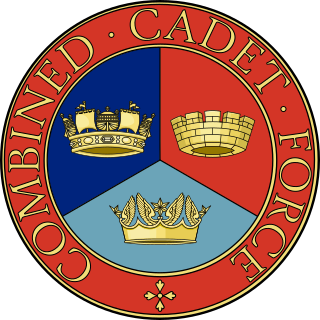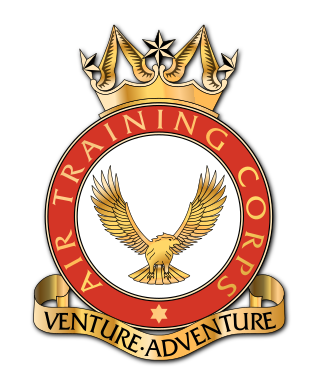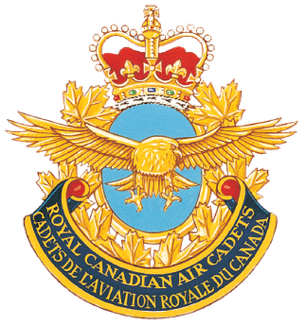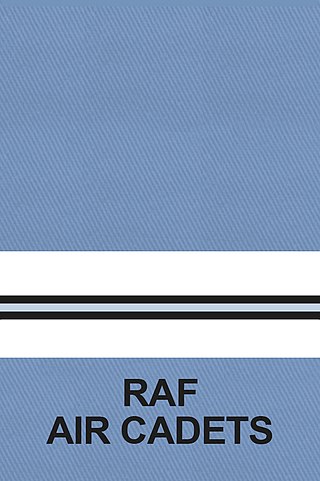
A non-commissioned officer (NCO) is a military officer who does not hold a commission. Non-commissioned officers usually earn their position of authority by promotion through the enlisted ranks. In contrast, commissioned officers usually enter directly from a military academy, officer training corps (OTC) or reserve officer training corps (ROTC), or officer candidate school (OCS) or officer training school (OTS), after receiving a post-secondary degree.

The Combined Cadet Force (CCF) is a youth organisation in the United Kingdom, sponsored by the Ministry of Defence (MOD), which operates in schools, sub divided into Royal Navy, Royal Marines, Army and Royal Air Force sections. Its aim is to "provide a disciplined organisation in a school so that pupils may develop powers of leadership by means of training to promote the qualities of responsibility, self reliance, resourcefulness, endurance and perseverance".

The Air Training Corps (ATC) is a British volunteer youth organisation of the United Kingdom; aligned to, and fostering the knowledge and learning of military values, primarily focussing on military aviation. Part of the Royal Air Force Air Cadets (RAFAC), the ATC is sponsored by the Royal Air Force (RAF) and the wider Ministry of Defence (MoD). The majority of Air Training Corps staff are volunteers, though some staff are paid for full-time work; including Commandant Air Cadets, who is a Royal Air Force officer as part of a Full Term Reserve Service commitment.

The Royal Canadian Air Cadets is a Canadian national youth program for young individuals aged 12 to 19. Under the authority of the National Defence Act, the program is administered by the Canadian Forces (CF) and funded through the Department of National Defence (DND). Additional support is provided by the civilian Air Cadet League of Canada (ACLC). Together with the Royal Canadian Sea Cadets and Royal Canadian Army Cadets, it forms the "largest federally funded youth program in the country". Cadets are not members of the military and are not obliged to join the Canadian Forces.
Under officer is an appointment held by the most senior cadets at some Commonwealth officer training establishments and in University Officers' Training Corps in the United Kingdom, and also a rank used in some Commonwealth cadet forces.
Officer Cadet is a rank held by military cadets during their training to become commissioned officers. In the United Kingdom, the rank is also used by members of University Royal Naval Units, University Officer Training Corps and University Air Squadron; however, these are not trainee officers with many not choosing a career in the armed forces.

Flight sergeant is a senior non-commissioned rank in the Royal Air Force and several other air forces which have adopted all or part of the RAF rank structure. It is equivalent to a staff sergeant or colour sergeant in the British Army, a colour sergeant in the Royal Marines, and a chief petty officer in the Royal Navy, and has a NATO rank code of OR-7. In the RAF, flight sergeant ranks above chief technician and below warrant officer.

The New Zealand Air Training Corps is one of the three corps in the New Zealand Cadet Forces (NZCF), alongside the New Zealand Sea Cadet Corps and the New Zealand Cadet Corps. It is funded in partnership between the Royal New Zealand Air Force (RNZAF) and local communities. Members are civilians with no obligation to enlist in the New Zealand Defence Force (NZDF). Should a cadet enlist, their service in the ATC cadet does not translate into higher pay, rank, or seniority.

The National Cadet Corps (NCC) is the youth wing of the Indian Armed Forces with its headquarters in New Delhi, India. It is open to school and college students on voluntary basis as a Tri-Services Organisation, comprising the Army, the Navy and the Air Force. Cadets are given basic military training in small arms and drill. Officers and cadets have no liability for active military service once they complete their course.

Air Marshal Geoffrey David Shepherd is a retired senior officer in the Royal Australian Air Force (RAAF), who served as Chief of Air Force from 2005 until 2008.

Acting pilot officer is the lowest commissioned grade in the Royal Air Force. Acting pilot officer is not an actual military rank, therefore acting pilot officers are regraded to pilot officer instead of receiving a promotion. Unlike other RAF ranks which officers may hold in an acting capacity, acting pilot officer is maintained as a separate grade.
Like the British Army, the Australian Army does not use the term 'enlisted' to describe its non-commissioned ranks. Instead, personnel who are not commissioned officers are referred to as other ranks. These are soldiers, non-commissioned officers (NCOs) and warrant officers (WOs). Warrant officers are appointed by a warrant which is signed by the Chief of the Army. The insignia for non-commissioned ranks are identical to the British Army up to the rank of warrant officer class two. Since 1976, WO1s and the WO in the Australian Army wear insignia using the Australian Coat of Arms.

RAAF Base Wagga is a Royal Australian Air Force (RAAF) military air base located 11 kilometres (6.8 mi) south-east of Wagga Wagga, in the suburb of Forest Hill, New South Wales, Australia.

The Australian Defence Force Academy (ADFA) is a tri-service military Academy that provides military and academic education for junior officers of the Australian Defence Force in the Royal Australian Navy (RAN), Australian Army and Royal Australian Air Force (RAAF). In 2016 the Academy began accepting civilian students in its undergraduate courses.
The Australian Defence Force's (ADF) ranks of officers and enlisted personnel in each of its three service branches of the Royal Australian Navy (RAN), the Australian Army, and the Royal Australian Air Force (RAAF) inherited their rank structures from their British counterparts. The insignia used to identify these ranks are also generally similar to those used in the British Armed Forces.

The Australian Defence Force Cadets (ADFC) consists of three Australian Defence Force affiliated, community-based, youth development organisations of approximately 27,834 cadets and 4,405 cadet staff in 579 units and squadrons across Australia. Coordination of the Australian Defence Force Cadets is via the ADF HQ unit called Reserve and Youth Division, with Commander ADF Cadets - directly accountable to VCDF. The ADFC is funded by the Australian Government through the Department of Defence, in partnership with the community.
Air Vice Marshal Julie Hammer, is an Australian engineer and a retired senior officer in the Royal Australian Air Force (RAAF). She was the first woman to be promoted to one-star rank, and also the first woman to be promoted to two-star rank, in the Australian Defence Force. She was also the first woman to command an operational unit in the RAAF.

A warrant officer (WO) in the British Armed Forces is a member of the highest-ranking group of non-commissioned ranks, holding the King's Warrant, which is signed by the Secretary of State for Defence.
Warrant Officer of the Air Force (WOFF-AF) is the senior Warrant Officer in the Royal Australian Air Force (RAAF). It is a singular appointment, being it is only held by one person at any time. The special insignia for the WOFF-AF is the Australian Coat of Arms encircled by a wreath of Australian native flora. The current Warrant Officer of the Air Force is Ralph Clifton.
The Queensland University Squadron (QUS) was an active Citizens Air Force (CAF) squadron, being part of the Royal Australian Air Force (RAAF) and tasked with training commissioned officers for the RAAF General Reserve recruited from University of Queensland undergraduates from 1950 to 1973. It trained 600 RAAF commissioned officers over 24 years.






































